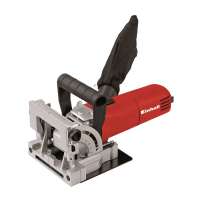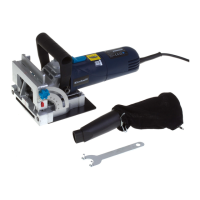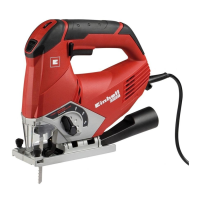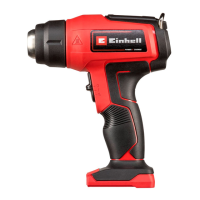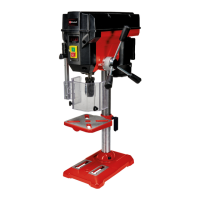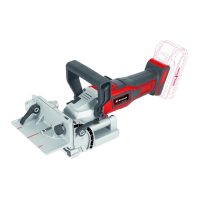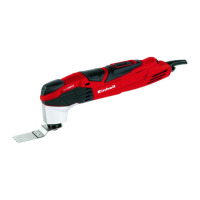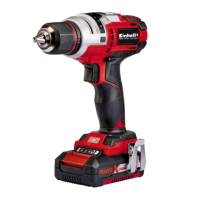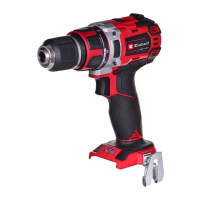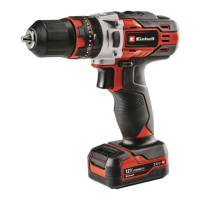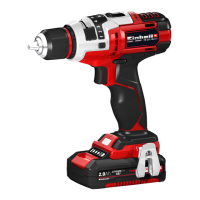GBGB
- 29 -
b) Avoid bodily contact with earthed sur-
faces such as pipes, heating, ovens and
fridges. The risk of electric shock is increa-
sed if your body is earthed.
c) Keep the tool out of water and away
from moisture. The ingress of water into an
electric tool increases the risk of an electric
shock.
d) Do not use the power cable to carry the
electric tool, to hang it up or to pull it out
of the socket. Keep the cable away from
heat, oil, sharp edges and moving parts
of the appliance. Damaged or entangled
cables increase the risk of an electric shock.
e) If you are working outdoors with an elec-
tric tool, only use extension cables which
are designed specically for this purpose.
Using specially designed outdoor extension
cables, the risk of electric shock is reduced.
f) If operation of the electric tool in a damp
environment can not be avoided, use a
earth-leakage circuit-breaker. The earth-
leakage circuit-breaker reduces the risk of an
electric shock.
3. Safety of persons
a) Be careful, watch what you are doing and
use an electric tool sensibly. Do not use
the tool if you are tired or under the inu-
ence of drugs, alcohol or medication. A
moment of distraction when using the electric
tool can result in serious injuries.
b) Wear personal protection equipment
and always wear safety goggles. Wearing
personal protection (such as dust masks,
non-slip safety shoes, safety helmet or ear
protection, depending upon the type and use
of the electric tool) reduces the risk of injury.
c) Make sure that the appliance cannot start
up accidentally. Ensure that the electric
tool is switched o before you connect
it to the power supply and/or insert the
battery, or pick up or carry the tool. If your
nger is on the switch whilst carrying the elec-
tric tool or if you connect the appliance to the
mains when it is switched on, this can lead to
accidents.
d) Remove keys and wrenches before swit-
ching on the electric tool. A tool or key
which comes into contact with rotating parts
of the appliance can lead to injuries.
e) Avoid abnormal working postures. Make
sure you stand squarely and keep your
balance at all times. In this way, you can
control the electric tool better in unexpected
circumstances.
f) Wear suitable work clothes. Do not wear
loose clothing or jewellery. Keep hair, clo-
thes and gloves away from moving parts.
Loose clothing, jewellery or long hair can get
trapped in moving parts.
g) If vacuuming devices and draining de-
vices can be tted, make sure that these
are correctly attached and correctly used.
The use of a dust extraction system can redu-
ce the danger posed by dust.
h) Do not allow yourself to be lulled into a
false sense of security and do not ignore
the safety regulations covering electric
power tools, even if you are familiar with
the power tool after having used it many
times. Carelessness can lead to serious inju-
ries in just a fraction of a second.
4. Usage and treatment of the electric tool
a) Do not overload the appliance. Use the
correct tool for your work. You will be able
to work better and more safely within the gi-
ven performance boundaries.
b) Do not use an electric tool with a defec-
tive switch. An electric tool that cannot be
switched on or o is dangerous and must be
repaired.
c) Pull the plug out of the socket and/or
remove the battery before making any ad-
justments to the appliance, changing ac-
cessories or put the appliance down. This
safety measure prevents starting the electric
tool unintentionally.
d) Keep unused electric tools out of the
reach of children. Do not allow people
who are not familiar with the appliance or
who have not read these instructions to
use the appliance. Electric tools are dange-
rous if they are used by inexperienced people.
e) Clean your electric tool carefully. Check
whether moving parts are functioning
properly and not jamming, whether parts
are broken or damaged enough that the
functioning of this electric tool is aec-
ted. Damaged parts must be repaired be-
fore using the appliance. Many accidents
are caused by badly maintained electric tools.
f) Keep your cutting tools sharp and clean.
Carefully maintained cutting tools with sharp
cutting edges will jam less and are easier to
control.
g) Make sure to use electric tools, accesso-
ries, spare parts, etc. in accordance with
these instructions. Take the conditions
in your work area and the job to perform
into account. Using electric tools for any
purpose other than the one for which they are
intended can lead to dangerous situations.
h) Keep the handles and grip surfaces dry,
clean and free from oil and grease. If the
handles and grip surfaces are slippery, it will
not be possible to operate and control the
power tool safely in unforeseen situations.
5. Service
a) Have your electric tool repaired only by
trained personnel and/or the authorized
service agent, using only genuine spare
parts. This will ensure that your electric tool
remains safe to use.
Special safety information
Always secure the workpiece if possible: Use
clamps or a vise to hold the workpiece securely.
This is far safer than holding it in your hand and
also means that you have both hands free to ope-
rate the electric tool.
Safety information for planes
•
Wait for the knife shaft to stop before you
put down the electric equipment. An expo-
sed rotating knife shaft can become caught
on the surface and result in loss of control
and serious injuries.
•
Hold the electric equipment only by the
insulated handles because the knife shaft
might strike the equipment‘s own power
cable. Contact with a live cable might also
make the metal parts of the equipment live
and cause an electric shock.
•
Use clamps or some other means to fas-
ten and secure the workpiece to a sturdy
surface. If you hold the workpiece only with
your hand or against your body it will remain
unstable and might cause you to lose control.
•
Ensure that there are no foreign objects
adhering to the workpiece in order to avoid
damaging the electric hand plane.
•
Hold the tool by its handle using both hands
and place the front base plate of the plane on
the workpiece. The base plates must evenly
rest on the workpiece during the planing pro-
cess.
•
Allow the tool to reach its maximum operating
speed before you start to plane.
•
Set the planing depth to 0 mm when you have
finished working.
•
Replace used planing knives with a set of
Anl_SA_TE_PL_900_SPK8.indb 29Anl_SA_TE_PL_900_SPK8.indb 29 12.10.2020 15:00:0712.10.2020 15:00:07
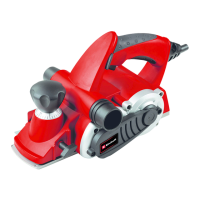
